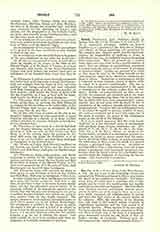

Ine (INI or INA), Saint, King of the West Saxons, d. 728. He was a son of the underking Cenred and ascended the West-Saxon throne in 688, a year before the death of his predecessor Caedwalla. For thirty-seven years he ruled over a turbulent and warlike people, and by virtue of a varied genius was equally successful as a warrior and legislator. His first efforts were directed towards establishing internal peace, and in the fifth year of his reign he drew up a set of laws which regulated the administration of justice and fixed the legal status of the various classes of his subjects. With the exception of the Kentish laws this code is the earliest extant specimen of Anglo-Saxon legislation, and for that reason is of particular interest. When matters in his own realm had been adjusted, Ine turned his attention to With-red, King of Kent, and at the head of a formidable army demanded weregild for the death of Mul (or Mollo), brother of Caedwalla. Withred paid the full compensation—thirty thousand pounds of silver—and admitted the supremacy of the West-Saxons over all the country held by the English south of the Thames. By successive conquests, Ine added several districts to the western provinces of his domain, and after a bitter war conquered Geraint, King of Cornwall, and built a fortress on the Tone, at the site of the present Taunton. Throughout his entire reign Ine was particularly solicitous for the welfare of religion and religious establishment, founding many monasteries and endowing those already in existence. The Abbey of Glastonbury was erected by him, with the funds, it is thought, which came from the were-gild collected from Withred. Other monastic establishments which were recipients of his bounty were those at Malmesbury, Wimborne, Nursling, Tisbury, Waltham, and Sherborne.
Worn out by his long rule, Ine determined to abdicate in favor of Aethelheard and Oswald, and to make his peace with God. In pursuance of this project, he convened the Witenagemot and formally announced his abdication. With his wife he proceeded to Rome, to watch and pray at the tomb of the Apostles in the guise of a poor and pious pilgrim. While there he founded a hospice or home for English pilgrims, in the district known as Burgus Saxonum, the modern Borgo. Some historians trace the foundation of the English College at Rome back to this hospice. The memory of the hospice still lives in the Church of San Spirito in Sassia, formerly S. Maria in Saxia; it is thought that King Ine and his Queen, Ethelburga, lie buried in this church or in the atrium of St. Peter’s. They died blessing God that they had been allowed to lay their dust in the consecrated soil of Rome.
STANLEY QUINN

